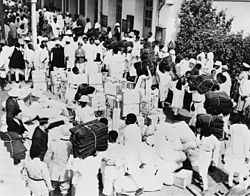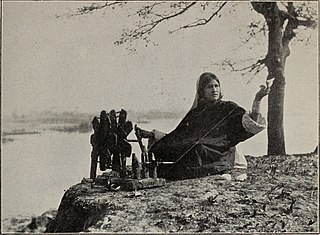

Cotton is grown throughout Ethiopia at elevations above 1000 meters and below 1400 meters. [1] Because most of the lowlands lack adequate rainfall, cotton cultivation depends largely on irrigation.


Cotton is grown throughout Ethiopia at elevations above 1000 meters and below 1400 meters. [1] Because most of the lowlands lack adequate rainfall, cotton cultivation depends largely on irrigation.
Cotton production has long been underway in Ethiopia. Before the revolution, large-scale commercial cotton plantations were developed in the Awash Valley [ citation needed ] and the Humera areas. The Tendaho Cotton Plantation in the lower Awash Valley was one of Ethiopia's largest cotton plantations. Rain-fed cotton also grew in Humera, Bilate, and Arba Minch.
In 1867 it was reported that there were plans to construct a 362-kilometre (225-mile) road from the Ethiopian cotton fields to the Red Sea to trade with Egypt and Turkey. [2] Since the revolution, most commercial cotton has been grown on irrigated state farms, mostly in the Awash Valley area. Production jumped from 43,500 tons in 1974/75 to 74,900 tons in 1984/85. Similarly, the area of cultivation increased from 22,600 hectares in 1974/75 to 33,900 hectares in 1984/85. [1]
Given its excellent growing conditions, abundance of raw materials and availability of land, Ethiopia has the potential to become a major global cotton producer but the cotton industry in Ethiopia as of 2011 is far behind that of the coffee industry and cereal production. [3] There are however, significant obstacles to the development of the industry in Ethiopia due to a distinct lack of administrative bodies to monitor and certify agricultural practices in the country and to process cotton in factories on a wide-scale commercial level. However, the development of the textile industry is a priority of the Ethiopian government in their economic growth strategy and in 2006 implemented an important privatization initiative to attract foreign and private enterprises to develop the sector. [3] Despite its lack of governance, the Ethiopian cotton industry is self-sufficient and as of 2002 provides some 50,000 tons annually to the textile industry of Ethiopia. [4]
Amibara is a woreda in Afar Region, Ethiopia. Part of the Administrative Zone 3, Amibara is bordered on the south by Awash Fentale, on the west by the Awash River which separates it from Dulecha, on the northwest by the Administrative Zone 5, on the north by Gewane, on the east by the Somali Region, and on the southeast by Oromia Region. Towns in Amibara include Awash Arba, Awash Sheleko, Melka Sedi and Melka Were.

Kafta Humera is a woreda in Tigray Region, Ethiopia. Located in the Western Tigray of Tigray, Kafta Humera is bordered on the south by Tsegede, on the west by Sudan, by the Tekezé River which separates Kafta Humera from Eritrea on the north, on the east by the North Western zone, and on the southeast by Welkait. Towns in Kafta Humera include Adi Hirdi and Humera.
Agriculture in Uzbekistan employs 28% of the country's labor force and contributes 24% of its GDP. Crop agriculture requires irrigation and occurs mainly in river valleys and oases. Cultivable land is 4.5 million hectares, or about 10% of Uzbekistan's total area, and it has to be shared between crops and cattle. Desert pastures cover fully 50% of the country, but they support only sheep.

Tajikistan is a highly agrarian country, with its rural population at more than 70% and agriculture accounting for 60% of employment and around 20% of GDP in 2020. As is typical of economies dependent on agriculture, Tajikistan has a low income per capita: Soviet Tajikistan was the poorest republic with a staggering 45% of its population in the lowest income “septile”. In 2006 Tajikistan still had the lowest income per capita among the Commonwealth of Independent States (CIS) countries: $1,410 compared with nearly $12,000 for Russia. The low income and the high agrarian profile justify and drive the efforts for agricultural reform since 1991 in the hope of improving the population's well-being.

Agriculture in Ethiopia is the foundation of the country's economy, accounting for half of gross domestic product (GDP), 83.9% of exports, and 80% of total employment.
Agriculture continued to be the mainstay of the economy of Haiti in the late 1980s; it employed approximately 66 percent of the labor force and accounted for about 35 percent of GDP and for 24 percent of exports in 1987. The role of agriculture in the economy has declined severely since the 1950s, when the sector employed 80 percent of the labor force, represented 50 percent of GDP, and contributed 90 percent of exports. Many factors have contributed to this decline. Some of the major ones included the continuing fragmentation of landholdings, low levels of agricultural technology, migration out of rural areas, insecure land tenure, a lack of capital investment, high commodity taxes, the low productivity of undernourished animals, plant diseases, and inadequate infrastructure. Neither the government nor the private sector invested much in rural ventures; in FY 1989 only 5 percent of the national budget went to the Ministry of Agriculture, Natural Resources, and Rural Development. As Haiti entered the 1990s, however, the main challenge to agriculture was not economic, but ecological. Extreme deforestation, soil erosion, droughts, flooding, and the ravages of other natural disasters had all led to a critical environmental situation.

Agriculture employs the majority of Madagascar's population. Mainly involving smallholders, agriculture has seen different levels of state organisation, shifting from state control to a liberalized sector.
Uganda's favorable soil conditions and climate have contributed to the country's agricultural success. Most areas of Uganda have usually received plenty of rain. In some years, small areas of the southeast and southwest have averaged more than 150 millimeters per month. In the north, there is often a short dry season in December and January. Temperatures vary only a few degrees above or below 20 °C but are moderated by differences in altitude.

Benin is predominantly a rural society, and agriculture in Benin supports more than 70% of the population. Agriculture contributes around 35% of the country's gross domestic product (GDP) and 80% of export income. While the Government of Benin (GOB) aims to diversify its agricultural production, Benin remains underdeveloped, and its economy is underpinned by subsistence agriculture. Approximately 93% of total agricultural production goes into food production. The proportion of the population living in poverty is about 35.2%, with more rural households in poverty (38.4%) than urban households (29.8%). 36% of households depend solely upon agricultural (crop) production for income, and another 30% depend on crop production, livestock, or fishing for income.

Agriculture in Sudan plays an important role in that country's economy. Agriculture and livestock raising are the main sources of livelihood for most of the Sudanese population. It was estimated that, as of 2011, 80 percent of the labor force were employed in that sector, including 84 percent of the women and 64 percent of the men.

The role of agriculture in the Bolivian economy in the late 1980s expanded as the collapse of the tin industry forced the country to diversify its productive and export base. Agricultural production as a share of GDP was approximately 23 percent in 1987, compared with 30 percent in 1960 and a low of just under 17 percent in 1979. The recession of the 1980s, along with unfavorable weather conditions, particularly droughts and floods, hampered output. Agriculture employed about 46 percent of the country's labor force in 1987. Most production, with the exception of coca, focused on the domestic market and self-sufficiency in food. Agricultural exports accounted for only about 15 percent of total exports in the late 1980s, depending on weather conditions and commodity prices for agricultural goods, hydrocarbons, and minerals.

Throughout its history, agriculture in Paraguay has been the mainstay of the economy. This trend has continued today and in the late 1980s the agricultural sector generally accounted for 48 percent of the nation's employment, 23 percent of GDP, and 98 percent of export earnings. The sector comprised a strong food and cash crop base, a large livestock subsector including cattle ranching and beef production, and a vibrant timber industry.

Agriculture in Spain is important to the national economy. The primary sector activities accounting for agriculture, husbandry, fishing and silviculture represented a 2.7% of the Spanish GDP in 2017, with an additional 2.5% represented by the agrofood industry.
Agriculture in Oman has been important for centuries. The government's economic development policy emphasizes the expansion of such non-oil sectors as agriculture, fishing, industry, and mining in its bid to diversify the economy and diminish its dependence on oil exports. The goal is to establish a sustainable economic base in preparation for the time when hydrocarbon reserves are depleted. The government launched several economic campaigns, naming 1988 and 1989 as Years of Agriculture and 1991 and 1992 as Years of Industry. Through these campaigns, the government has encouraged private-sector investment by allocating generous amounts of cash support for private industry to be disbursed mainly through official development banks. For example, the Oman Bank for Agriculture and Fisheries, created in 1981, extends loans at concessionary rates to individuals for whom farming or fishing is the principal activity. The bank acts as a distributive institution, receiving an interest subsidy from the government. In 1990 there were 1,308 loans, totaling RO4.7 million. Development programs also incorporate the government's policy of indigenization, with a large component of funds.
Despite the crisis in Syria, agriculture remains a key part of the economy. The sector still accounts for an estimated 26 percent of gross domestic product (GDP) and represents a critical safety net for the 6.7 million Syrians – including those internally displaced – who still remain in rural areas. However, agriculture and the livelihoods that depend on it have suffered massive losses . Today, food production is at a record low and around half the population remaining in Syria are unable to meet their daily food needs.

Farming systems in India are strategically utilized, according to the locations where they are most suitable. The farming systems that significantly contribute to the agriculture of India are subsistence farming, organic farming, industrial farming. Regions throughout India differ in types of farming they use; some are based on horticulture, ley farming, agroforestry, and many more. Due to India's geographical location, certain parts experience different climates, thus affecting each region's agricultural productivity differently. India is very dependent on its monsoon cycle for large crop yields. India's agriculture has an extensive background which goes back to at least 9 thousand years. In India, in the alluvial plains of the Indus River in Pakistan, the old cities of Mohenjo-Daro and Harappa experienced an apparent establishment of an organized farming urban culture. That society, known as the Harappan or Indus civilization, flourished until shortly after 4000 BP; it was much more comprehensive than those of Egypt or Babylonia and appeared earlier than analogous societies in northern China. Currently, the country holds the second position in agricultural production in the world. In 2007, agriculture and other industries made up more than 16% of India's GDP. Despite the steady decline in agriculture's contribution to the country's GDP, agriculture is the biggest industry in the country and plays a key role in the socio-economic growth of the country. India is the second-largest producer of wheat, rice, cotton, sugarcane, silk, groundnuts, and dozens more. It is also the second biggest harvester of vegetables and fruit, representing 8.6% and 10.9% of overall production, respectively. The major fruits produced by India are mangoes, papayas, sapota, and bananas. India also has the biggest number of livestock in the world, holding 281 million. In 2008, the country housed the second largest number of cattle in the world with 175 million.

Agriculture in Mexico has been an important sector of the country’s economy historically and politically even though it now accounts for a very small percentage of Mexico’s GDP. Mexico is one of the cradles of agriculture with the Mesoamericans developing domesticated plants such as maize, beans, tomatoes, squash, cotton, vanilla, avocados, cacao, various kinds of spices, and more. Domestic turkeys and Muscovy ducks were the only domesticated fowl in the pre-Hispanic period and small dogs were raised for food. There were no large domesticated animals.

Cotton production in Pakistan is integral to the economic development of the country. The nation is largely dependent on the cotton industry and its related textile sector, and the crop has been given a principal status in the country. Cotton is grown as an industrial crop in 15% of the nation's land during the monsoon months of May to August, known as the Kharif period, and is grown at a smaller scale between February and April. Pakistan occupied the fourth position among the cotton growers of the world, the first three being India, China and USA.

Cotton production in China pertains to cotton which is the prime cash crop of China. Its production was the highest in the world from 1982 until being overtaken by India. Twenty-four of the 35 provinces of China grow cotton, with nearly 300 million people involved in its production. It is the main input for textile industry of the country with cotton textiles now accounting for 80% use vis-à-vis 95% in the 1950s. The cotton textile industry employs over 10 million people. Its production in 2012–13 was 7.6 million tons, but in 2013–14 it dropped to 7 million tons. Historically, its introduction in China is considered a 'southernization', a crop which originated from southern Asia (India) during the "proto-globalization" period.
The British Cotton Growing Association (BCGA) was an organisation formed in 1902 from the various bodies connected with the Lancashire cotton industry which aimed to reduce that industry's dependence on supplies of raw cotton from the United States by promoting the development of cotton growing in the British Empire. It was described as a "semi-philanthropic" organisation, or combination of non-governmental organization, and a development agency, as it provided development funds without requiring any direct repayment, but did expect the Lancashire cotton industry to benefit indirectly in the longer term from the availability more secure cotton supplies.